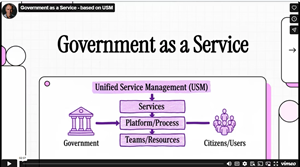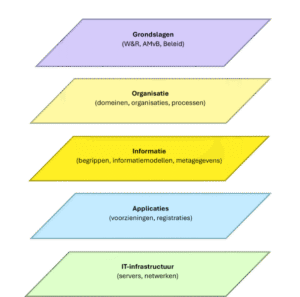The Dutch Government Reference Architecture - NORA - describes the architecture principles and models for interoperable digital service delivery within the government. The core consists of the 'Connecting Architecture Agreements' and an elaboration of the Five-layer Model consisting of the Foundations Layer, Organization Layer, Information Layer, Application Layer, and IT Infrastructure Layer (image on the right). In addition, NORA shares sets of relevant architecture information such as Concepts, Standards, and Building Blocks.
However, until 2022, NORA did not define the internal management system of individual government service organizations in the Organizational Layer. After all, all government organizations were different... This changed when the NORA Management Board, in 2022, adopted the USM method for this purpose. The USM method was used to establish the NORA Basic Concept of Service Delivery ("Basisconcept van Dienstverlening"): the USM-based description of the Organization Layer in the architecture for government service delivery.
History of the Basic Concept of Service Delivery
In 2020, Jaap van den Berg (architect at DUO) argued that all architectures in government think from the perspective of the government and not from that of the citizen. He wondered what an Enterprise Architecture of the Citizen would look like and what we were missing because it did not exist. Through the NORA Expert group on Data Management and its chair, Wim Stolk, he came into contact with Eric Brouwer.
Eric had felt for years that government services could be improved and that architecture could play a role in this. At that time, he had just begun to further investigate and develop this instinct, based on existing reports and further research. He did this under the working title "Service Delivery Draft".
The introduction proved to be a happy one, and soon a group was formed that called in monthly to combine the two approaches, with Eric as the spokesperson: What should the architecture of service delivery look like if the citizen really is at the center? The discussions were fundamental, respectful, and critical: it often proved necessary to take a few steps back and review or rearrange existing ideas based on new or temporarily overlooked insights.
The addition of Jan van Bon (lead architect at SURVUZ Foundation, administrator of the USM method) to this working group ultimately led to one of the most fundamental rearrangements. After considerable discussion and reading, the working group decided that government service delivery is also ‘just’ service delivery and that the insights from USM were therefore fully applicable. Good organization and management of service delivery is a fundamnental condition for good government services.
The two most important questions were then where and how the language of USM needed to be modified to be appropriate in the government context and where details were needed to do justice to the unique position of the citizen. That citizens could be positioned as customers/consumers of government services quickly became clear when the participants produced the image below. The language adjustment consisted of replacing two terms that seemed to conflict with common government language usage: the term ‘customer’ was replaced by the term ‘afnemer’, and the term ‘service’ was replaced by the term ‘dienst’. Meanwhile, more and more policy documents show that ‘customer’ is accepted as a term, and ‘service’ is also being used more and more often. Because these are only terms, it does not affect the functioning of the Basic Concept of Service Delivery.

In a democratic system, citizens are represented at multiple levels by a representative body that articulates their interests. At each level, there is a governmental delivery organization that provides the agreed services to citizens. The figure is based on USM's Customer-Provider Interaction Model.

In a final reorganization, the group decided to make explicit the principles that were already implicitly present. Based on three principles, they examined the USM processes and applied the descriptions to the government where necessary, without modifying the underlying insights. The deliverable was published on the NORA website under the name ‘Basisconcept van Dienstverlening’, with the intention of laying a foundation for Dutch government service delivery.

Further development since 2022
After the Basic Concept of Service Delivery was established in 2022, the content of the NORA website was significantly expanded. This related to the details of USM on the one hand, but also to the application of the ideas to other parts of NORA and to practical situations on the other.
From the end of 2023, the Expert Group on Service Delivery is the administrator of the Basic Concept of Service Delivery. The Expert Group meets monthly and now has approximately 20 members. Interested parties can register to participate with Pieter Hoekstra. The Expert Group has already achieved many of its objectives and is now working on the broad acceptance of the ideas among government organizations. The Expert Group works closely with SURVUZ Foundation, the administrator of USM.
A free downloadable ebook describes in more detail how Government can act as a regular Service provider. You may also watch a 2-minute video on this ebook (below).



